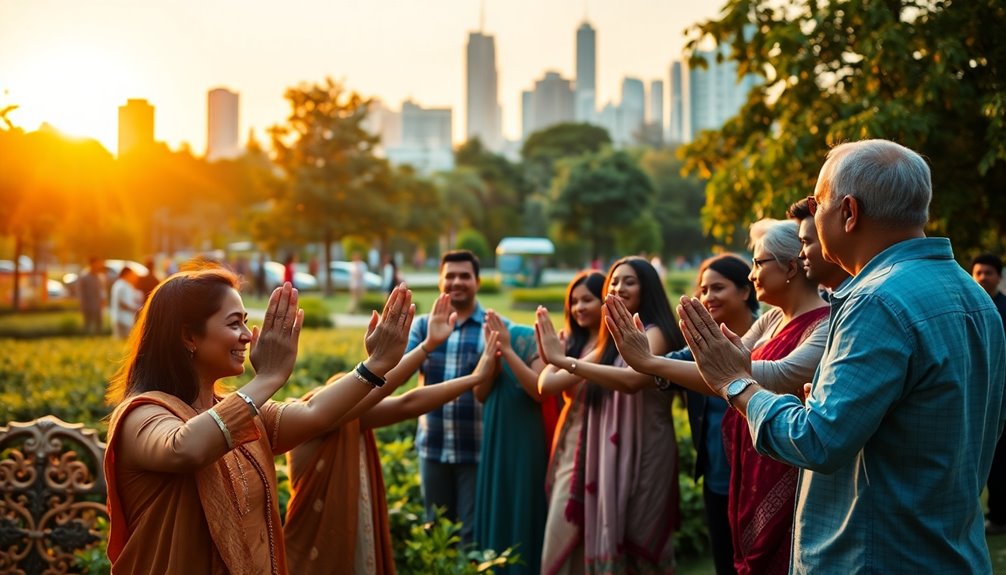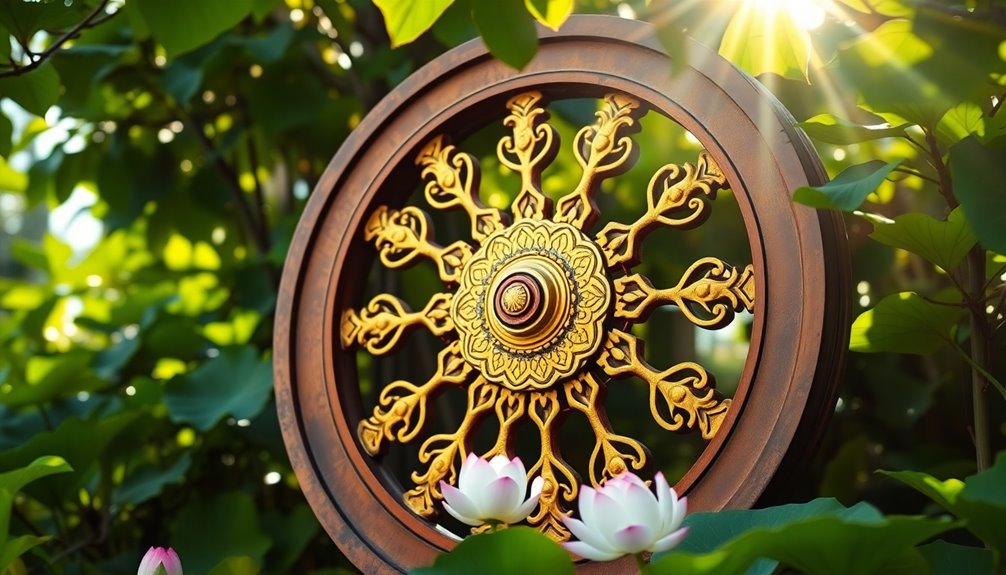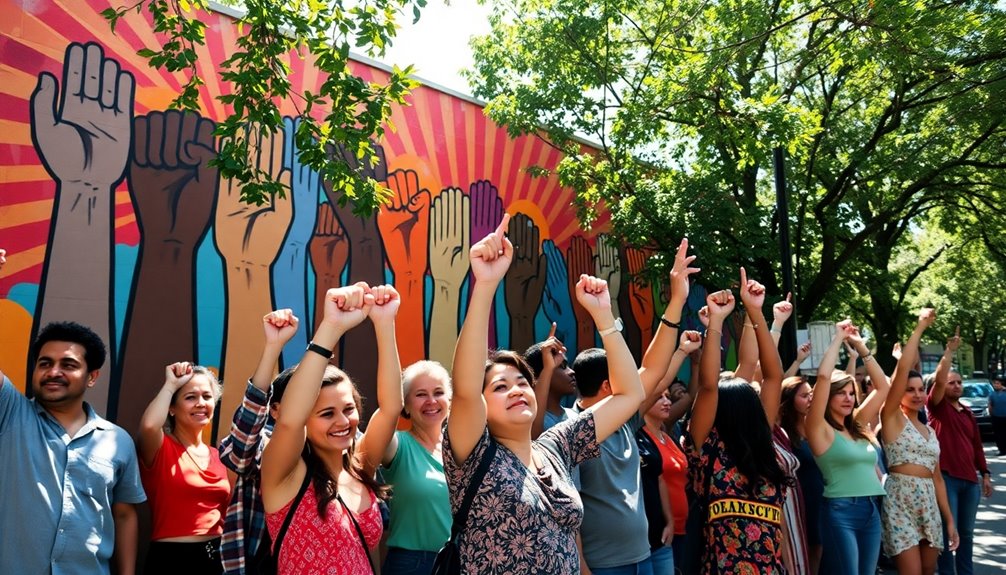The Namaste sign, translating to "I bow to you," carries deep respect and unity, rooted in Indian culture. You've likely noticed its surge in popularity in the West, especially through yoga and mindfulness practices. This gesture reflects a shared desire for connection and compassion while minimizing physical contact, especially post-COVID. As you acknowledge others with this greeting, you're not only fostering emotional bonds but also embracing a cultural exchange that transcends boundaries. If you're curious about how this practice enhances well-being and connects communities, there's much more to discover about its impact.
Key Takeaways
- Namaste symbolizes respect and acknowledgment, fostering emotional connections that resonate with diverse cultures and individuals in the West.
- Its popularity in yoga and mindfulness practices has made Namaste a common greeting in Western societies, bridging cultural gaps.
- The COVID-19 pandemic accelerated the adoption of Namaste as a contactless greeting, emphasizing health and safety in social interactions.
- Namaste encourages mindfulness and community ties, promoting emotional well-being and reducing stress in modern interactions.
- As a global greeting, Namaste reflects evolving societal values, emphasizing compassion and understanding in everyday communications.
Significance of Namaste

Namaste often serves as a profound expression of respect and acknowledgment between individuals. You might've noticed that when someone greets you with this gesture, it's more than just a simple hello; it's a heartfelt connection. Namaste means "I bow to you," and it embodies a deep recognition of the divine within each person.
This gesture of respect, where palms come together in front of the heart, promotes unity and mindfulness, especially in today's world.
In the wake of the COVID-19 pandemic, Namaste gained traction as a safer alternative to handshakes. You can find it being used in airports, public spaces, and various modern settings, showing its universal appeal.
As you embrace this traditional gesture, you participate in a practice that transcends cultural boundaries, fostering emotional connections without physical contact.
The significance of Namaste lies not only in its historical roots but also in its ability to adapt to contemporary social norms. By acknowledging the divine within others, you contribute to a collective spirit of compassion and understanding, making Namaste a truly meaningful greeting in any context.
Cultural Origins and Traditions

You might be surprised to learn that Namaste has deep roots in ancient Indian traditions, with its origins tracing back to Sanskrit.
This gesture not only symbolizes respect but also highlights the shared connection among all individuals.
As you explore its historical significance, you'll notice how Namaste has adapted and transformed in various cultures around the world.
Historical Significance of Namaste
The gesture of bowing with hands pressed together at the heart, known as Namaste, carries deep historical significance rooted in ancient Indian traditions.
Derived from the Sanskrit words "namah" (to bow) and "te" (to you), it literally translates to "I bow to you." This simple yet profound gesture symbolizes respect and acknowledgment, and it's commonly used in Hinduism, Buddhism, and yoga practices.
When you perform Namaste, you're engaging in a rich cultural exchange that encompasses:
- Divine Connection: It fosters a sense of unity with the divine in yourself and others.
- Respect: It shows reverence for the person you're greeting.
- Gratitude: Namaste acts as an expression of thankfulness in interactions.
- Goodwill: It conveys a spirit of kindness and openness.
Historically, Namaste has served not only as a greeting but also as a versatile expression of humility.
As it has transcended cultural boundaries, its popularity has surged globally, particularly in multicultural environments.
This growing appreciation for Namaste reflects our collective desire for mindfulness and deeper connections in social interactions.
Global Cultural Adaptation
Cultural exchange fosters a rich tapestry of interactions, and Namaste exemplifies this beautifully as it adapts across various societies. Originating from ancient Indian traditions, Namaste carries a profound meaning, symbolizing respect and the acknowledgment of the divinity within each individual. The Sanskrit roots of the term highlight its essence: "I honor or bow to you."
As globalization accelerates, you're witnessing a remarkable global cultural adaptation of Namaste, allowing it to transcend its origins. Incorporating Namaste into daily interactions promotes a mindful approach to greetings. The rise of yoga and mindfulness practices in the West has been pivotal in this shift, as people embrace Namaste as a respectful alternative to traditional handshakes.
This gesture fosters emotional connections, reminiscent of its ancient purpose. By showing respect through Namaste, you're not just adopting a greeting; you're participating in a broader cultural dialogue that emphasizes inclusivity and mutual acknowledgment.
As you navigate this evolving landscape, remember that Namaste serves as a reminder of our shared humanity, inviting you to honor the divine in others while deepening your connections in an increasingly interconnected world.
Post-COVID Greeting Adaptations
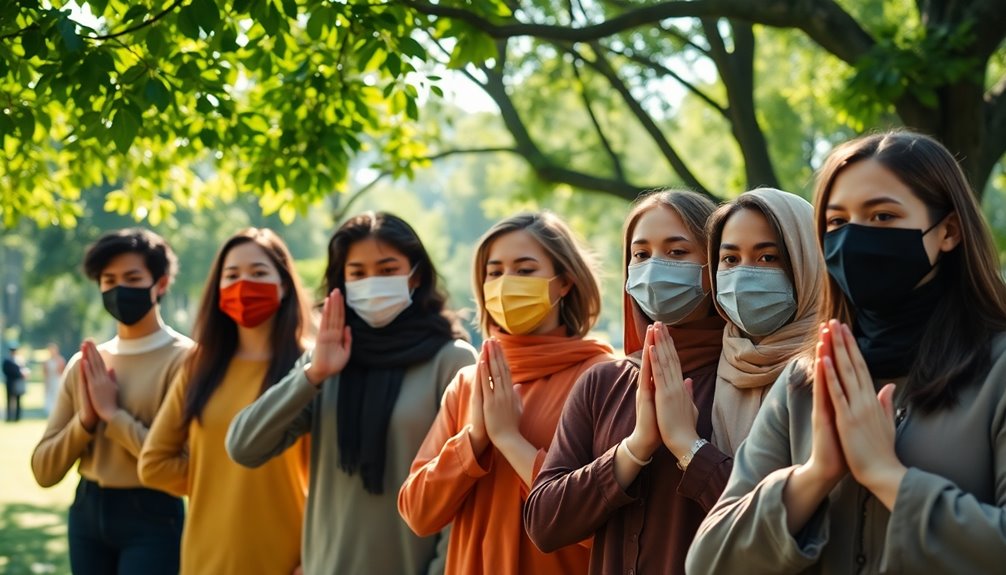
After COVID-19, you might've noticed a shift in how people greet each other, with a strong focus on hygiene and safety.
The Namaste gesture not only minimizes physical contact but also fosters an emotional connection, making it a perfect choice for today's world.
As you navigate these new social norms, it's interesting to see how greetings have evolved to balance safety with a sense of community.
Hygiene and Safety Focus
Frequently, people are adapting their greeting habits in response to heightened hygiene awareness and safety concerns stemming from the COVID-19 pandemic. One of the most significant shifts has been the embrace of the Namaste gesture as a respectful and contactless alternative to traditional greetings.
This change not only reflects a commitment to hygiene but also emphasizes the importance of maintaining social connections. Energy-efficient models can be seen as a metaphor for how effective and mindful interactions can lead to a more positive environment. Moreover, this shift encourages individuals to recognize patterns of behavior that can enhance their connections with others.
Consider these aspects of the Namaste greeting:
- Contactless: It eliminates physical touch, reducing the risk of virus transmission.
- Respectful: It conveys a sense of honor and acknowledgment without invading personal space.
- Mindful: It encourages a more intentional approach to interactions, promoting awareness of one's surroundings.
- Community-oriented: Public figures and celebrities have popularized Namaste to foster solidarity during challenging times.
Additionally, the use of contactless greetings can help individuals avoid the pitfalls of narcissistic behavior, which often thrives in environments lacking genuine respect and empathy.
Emotional Connection Enhancement
In a world reshaped by the pandemic, many have turned to the Namaste gesture to enhance emotional connections while respecting personal space. This contactless greeting allows you to express warmth and regard without physical touch, making it a perfect fit for today's social landscape.
As you navigate interactions post-COVID, embracing Namaste promotes a sense of closeness and mindfulness. You can convey respect and empathy while maintaining the necessary distance, fostering connections that feel genuine and heartfelt. This gesture not only reflects your adaptability but also reinforces social bonds during a time when many face isolation.
The beauty of Namaste lies in its ability to transcend cultural barriers, reminding us of our shared humanity. By adopting this greeting, you're joining a global movement that values emotional connections more than ever.
The pandemic has heightened awareness of hygiene and personal space, making Namaste a symbol of resilience in maintaining relationships. Moreover, practicing healthy boundaries is crucial in nurturing these connections while ensuring personal comfort.
Ultimately, by choosing Namaste, you're not just greeting someone; you're fostering a deeper emotional connection that resonates with respect and understanding, helping to weave a stronger fabric of community in these challenging times.
Modern Observations and Usage
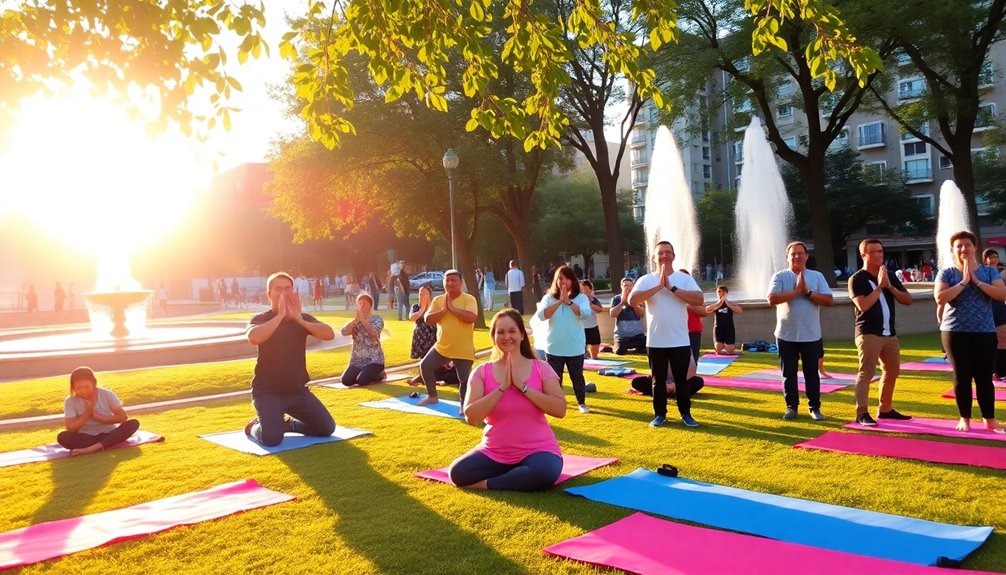
How has the gesture of Namaste evolved in modern society? This ancient sign of respect is now a common sight in various settings, from yoga studios to airports. You may notice people greeting each other with Namaste, reflecting a cultural shift towards mindfulness and respectful interactions.
Here are some observations about its modern usage:
- Public Spaces: You'll see Namaste used in parks and community events, enhancing social interactions in diverse settings.
- Yoga Teachers: Many yoga teachers incorporate Namaste at the start and end of classes, reinforcing its spiritual significance and connection to mindfulness.
- Celebrities: Influential figures have embraced Namaste, promoting it as a safe, contactless greeting during the COVID-19 pandemic.
- Cultural Bridge: Namaste serves as a versatile greeting that transcends cultural boundaries, fostering connections among people from different backgrounds.
As you engage with others, remember that Namaste isn't just a gesture; it's a meaningful expression of respect and recognition that resonates with the evolving values of modern society.
Personal Experiences and Insights

Experiencing Namaste in various settings often brings a profound sense of connection and respect among individuals. You might notice that when you greet someone with Namaste, it transcends mere words; it embodies a deeper acknowledgment of the shared humanity between you. This gesture—where the divine in me honors the divine in you—creates an environment ripe for mindful interactions.
| Setting | Personal Insight |
|---|---|
| Yoga Classes | Enhances community feeling during practice |
| Multicultural Events | Fosters understanding between diverse backgrounds |
| Casual Gatherings | Promotes respect and gratitude among friends |
As younger generations adopt Namaste in both casual and formal environments, you can see how this shift reflects a growing appreciation for cultural expressions. Incorporating Namaste into daily life helps you better understand and connect with others, especially during times of social distancing. Many individuals report feeling a sense of peace and belonging, reinforcing the idea that this simple gesture can bridge gaps and foster unity. Additionally, the practice of high vibrational energy can enhance the feelings of connection experienced through Namaste.
Health Benefits of Namaste

Practicing Namaste offers multiple health benefits that can enhance your overall well-being.
This simple yet profound gesture can reduce stress levels and promote relaxation, leading to improved mental health and emotional balance. By activating your parasympathetic nervous system, Namaste enhances brain reflex pathways and boosts cognitive function.
Here are some key benefits you might experience:
- Reduced stress: Engaging in Namaste can help you unwind and lower anxiety levels.
- Improved mental clarity: Mindfulness practices like Namaste sharpen your focus and enhance productivity.
- Boosted immune function: Regular practice supports your physical health and resilience against illness.
- Strengthened community ties: Incorporating Namaste fosters a sense of belonging, essential for emotional support.
Global Acceptance and Future Implications
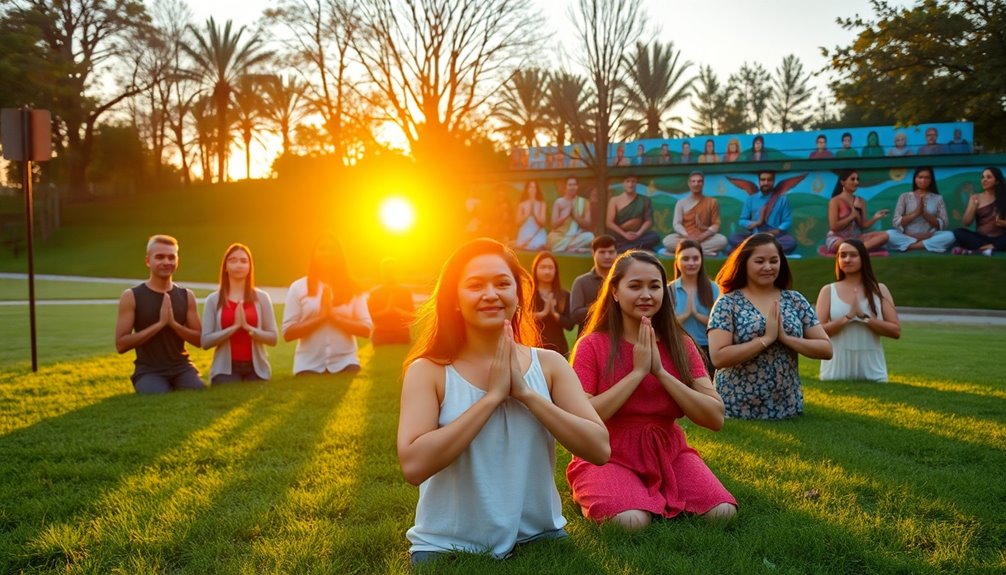
Why has Namaste become a widespread greeting in recent years? Its rise can be traced back to the COVID-19 pandemic, where people sought safe alternatives to physical contact. This gesture not only offers a hygienic option but also embodies mindfulness, encouraging a moment of connection without the need for touch.
You might notice Namaste being used in yoga classes and various social settings, reflecting a growing appreciation for cultural respect and spiritual greetings.
As you observe its increasing popularity, you'll find that public figures and celebrities have embraced Namaste, further promoting its use. This acceptance signifies a shift towards more inclusive interactions, fostering a sense of unity among diverse communities. Namaste transcends cultural boundaries, evolving into a universal greeting that resonates with many.
Looking ahead, the global acceptance of Namaste suggests a future where mindfulness and respect become integral to daily interactions. This spiritual greeting isn't just a trend; it represents a deeper connection to values that promote compassion and understanding.
As you integrate Namaste into your life, consider how it can enrich your relationships and contribute to a more harmonious society.
Frequently Asked Questions
What Does Namaste Literally Mean Spiritually?
Namaste literally means "I bow to you," reflecting a deep spiritual respect for the divine in yourself and others.
When you say it, you're acknowledging the sacredness that exists within each person. This gesture promotes unity and connectedness, reminding you to see the divine in everyone you meet.
Can White People Say Namaste?
Can anyone truly claim a greeting as their own?
When you use "Namaste," it's crucial to understand its cultural roots and significance. If you approach it with respect and appreciation, there's room for it in your practices.
Many people from diverse backgrounds embrace it as a gesture of connection and peace. Just be mindful of its origins and be open to learning about the culture it comes from.
Respect goes a long way!
What Is the Meaning of Namaste 🙏?
Namaste means "I bow to you," reflecting deep respect and acknowledgment of the divine in others.
When you say it, you're recognizing the shared essence within everyone. This gesture, often accompanied by bringing your palms together at your heart and bowing your head, fosters connection and mindfulness.
It encourages compassion and unity, reminding you to treat others with kindness and respect, embracing the belief that there's a divine essence in every individual.
What Is the Scientific Reason Behind Namaste?
Have you ever wondered why a simple gesture can have such profound effects?
The scientific reasons behind Namaste include its ability to activate your parasympathetic nervous system, promoting relaxation and reducing stress. Engaging in this mindful practice boosts your emotional well-being, enhances mental clarity, and fosters community connection.
Plus, when paired with yoga, it can improve physical health by strengthening your immune system.
Conclusion
In a world that's constantly evolving, embracing the Namaste sign is like planting a seed of connection and respect. This simple gesture not only bridges cultures but also nurtures our shared humanity. As you greet others with Namaste, you're inviting positivity and mindfulness into your interactions. So, let this spiritual greeting flourish in your life, reminding you that even in a fast-paced society, a moment of peace can create ripples of understanding and unity.

